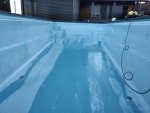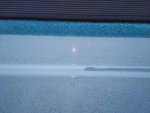Gelcoat materials are tricky. In general terms, they are thermosetting polymer materials. Typically thermosetting polymers start with a linear chain polymer and a mixture of shorter chain polymers which, when heat is applied, begin to cross link and harden. Once fully cross-linked, they become very hard and chemical resistant. They can not typically be reworked by heating as they simply break down when heated to high temperature rather than melt.
The thermosetting process can be quite slow with just heat applied and so the starting mixture usually has reactive cross linking agents added to it (organic peroxide’s) and sometimes a metal catalyst (cobalt usually which is why gel coats can sometime get black “cobalt spotting”). These reactive compounds greatly speed up the cross-linking process while reducing the temperatures needed to work the material.
However, application temperature is still a crucial factor as having too low a temperature will leave a significant amount of the unreacted starting material in the mix. The starting polymers are much softer and susceptible to hydrolysis and oxidation than the final crosslinked material. Gelcoat restoration is always a tricky process and the hazy appearance you see happens to a lot of manufactured fiberglass pools. It’s definitely not an installation issue. Poor water chemistry management and low quality manufacturing is usually the culprit. However, as you have seen, manufacturers will never accept the blame but rather classify it as a maintenance issue which relieves them of any warranty responsibility. It’s similar to how plaster problems (spotting, mottling, etc) are blamed on “water chemistry” when it has been clearly shown with technical studies that it’s an applicator/product issue.





